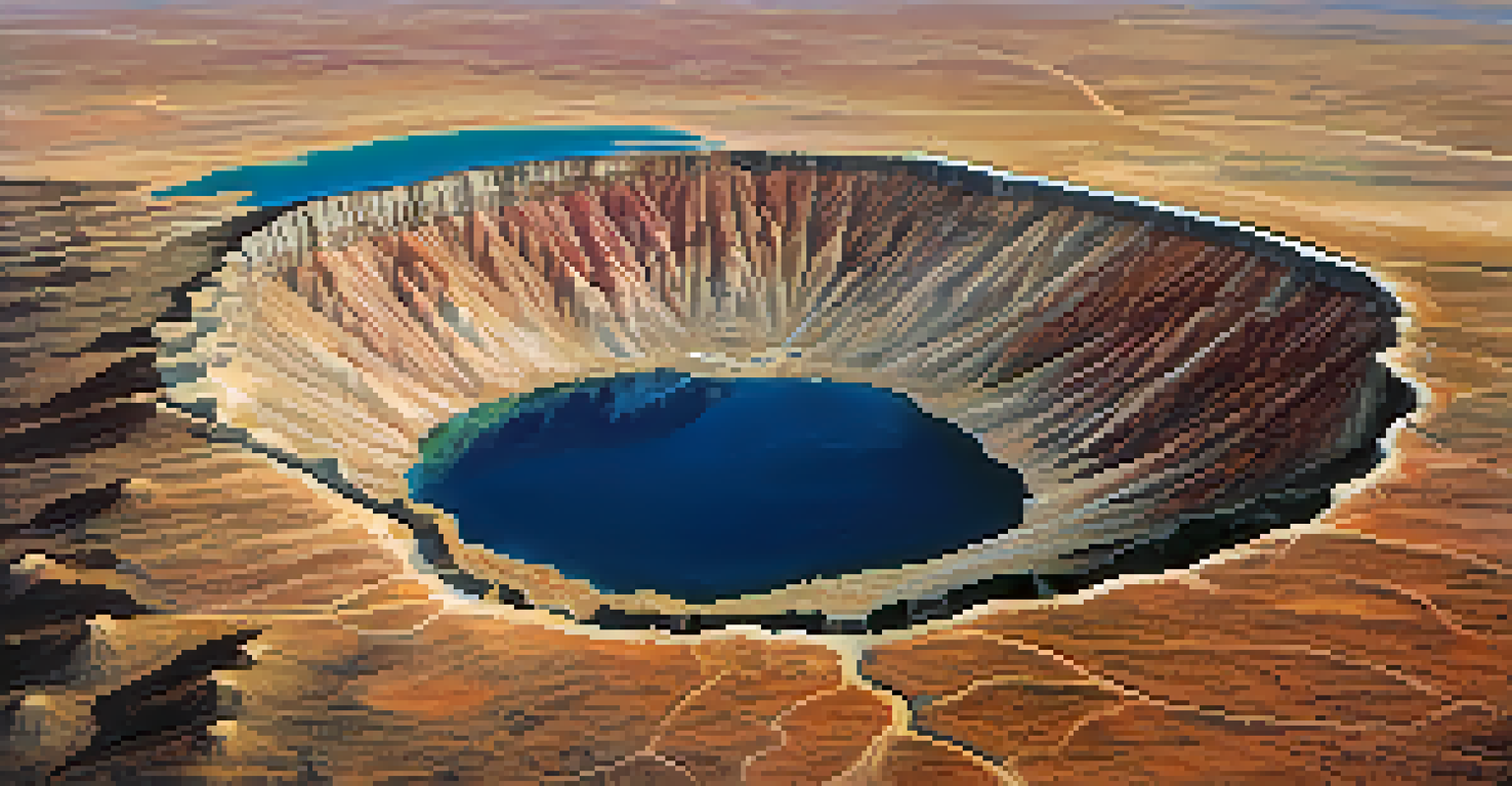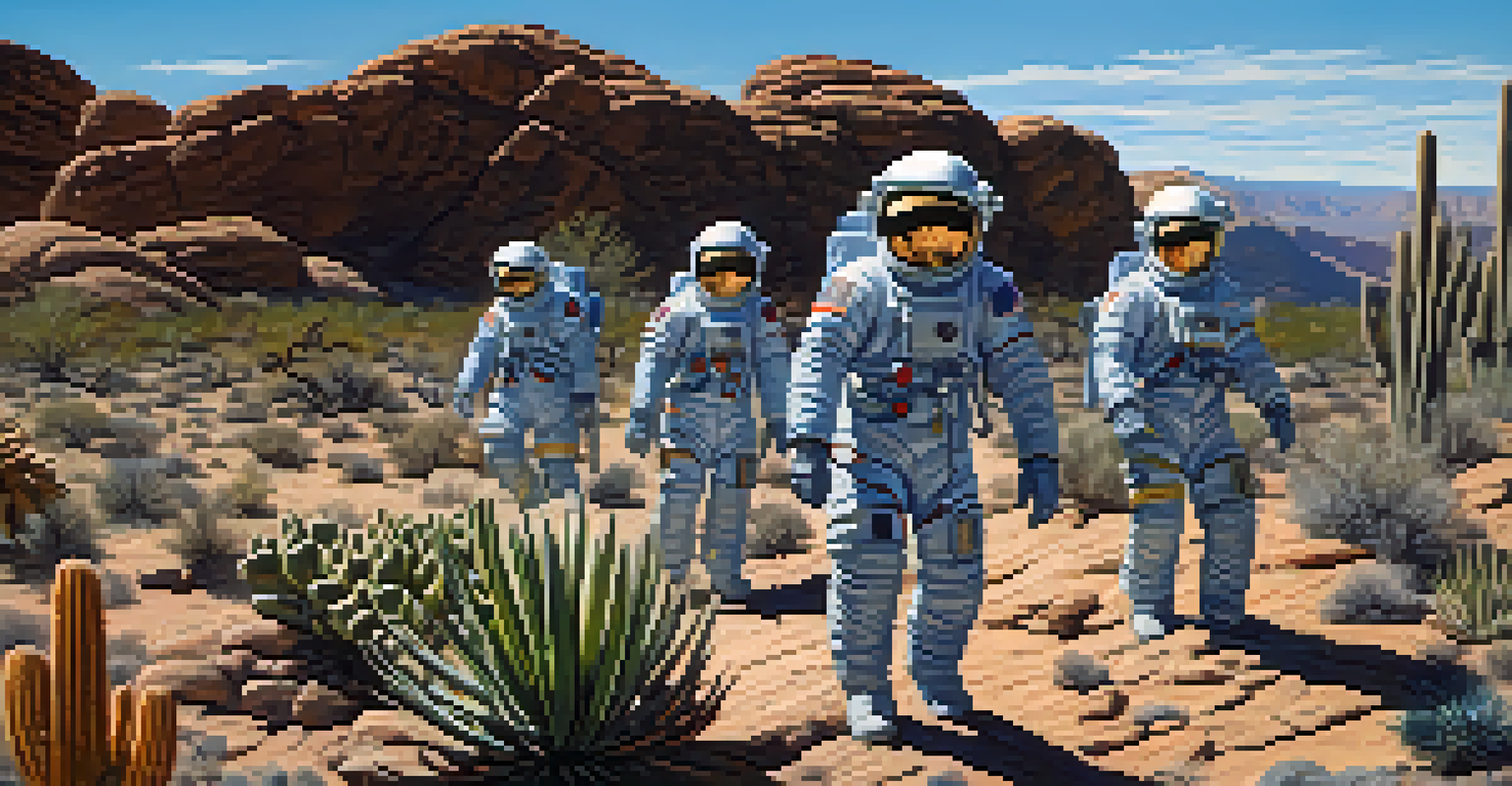The Historical Role of Arizona in U.S. Space Exploration

The Birth of Space Exploration in Arizona
Arizona's involvement in space exploration began in the mid-20th century, coinciding with the Cold War's technological race. The state's unique geography, featuring vast deserts and clear skies, made it an ideal location for testing various aerospace technologies. The establishment of facilities like the Lunar and Planetary Laboratory at the University of Arizona marked a significant turning point in this journey.
To confine our attention to terrestrial matters would be to limit the human spirit.
The Lunar and Planetary Laboratory became a hub for scientists and engineers, focusing on planetary science and space missions. This institution not only contributed to the understanding of our moon but also played a crucial role in the planning of missions to Mars and beyond. With Arizona's expansive landscapes mimicking other planets, it provided an excellent training ground for astronauts and researchers alike.
As the space race heated up, Arizona's role grew more prominent. The state started to attract major aerospace companies, which recognized the potential for collaboration with local universities and research institutions. This synergy laid the groundwork for many future missions and innovations in space exploration.
NASA's Presence and Impact in Arizona
NASA's establishment in 1958 brought a wave of opportunities to Arizona, as the agency sought to expand its research and development capabilities. The state became home to several NASA facilities, including the Johnson Space Center's Astronaut Training Program, which utilized Arizona's rugged terrain for training purposes. This collaboration significantly shaped the skills and experience of astronauts heading for space.

One notable example is the training astronauts received for lunar missions, employing Arizona's unique landscape to simulate the moon's surface. By traversing the rocky, arid environments of places like the Arizona desert, astronauts gained invaluable experience that would aid them during their actual missions. This hands-on training was crucial in preparing them for the challenges of space travel.
Arizona: A Hub for Space Innovation
The state's universities and research institutions drive advancements in space exploration through collaboration with NASA and private companies.
Moreover, Arizona hosted numerous scientific experiments and tests under NASA's auspices, leading to advancements in space technology. The state's researchers contributed to developing instruments used in various space missions, reinforcing Arizona's status as a vital player in the U.S. space exploration narrative.
The Role of Meteor Crater in Space Studies
Meteor Crater, located near Winslow, Arizona, is one of the best-preserved impact sites on Earth, making it a vital resource for scientists studying impact events. Its formation, dating back about 50,000 years, provides insights into planetary formation and collision processes. This geological wonder has attracted attention from space researchers and educators alike.
Space exploration is a force of nature unto itself that no other force in society can rival.
In the context of space exploration, Meteor Crater serves as a natural laboratory for understanding craters on other celestial bodies, such as the Moon and Mars. Researchers have used this site to improve models of impact craters, which are crucial for planning future missions to these distant worlds. This connection highlights how Arizona's natural landscape contributes to our understanding of the universe.
Furthermore, Meteor Crater has become a popular site for educational outreach, where visitors can learn about space science and geology. By fostering interest in these fields, Arizona helps inspire the next generation of scientists and engineers who will continue the legacy of space exploration.
The Arizona-Sonora Desert and Mars Exploration
The Arizona-Sonora Desert's striking resemblance to the Martian landscape has made it a prime site for Mars exploration training and simulations. NASA and other agencies frequently conduct field tests in this region to prepare for the challenges of exploring the Red Planet. The desert's conditions, including its rocky terrain and sparse vegetation, mirror those found on Mars, providing a realistic training ground.
Simulations held in the Sonoran Desert allow scientists to experiment with rovers and other technologies that will be used on Mars. These exercises help refine techniques for navigating and conducting research in extraterrestrial environments. This dedication to realistic training reflects Arizona's commitment to advancing space exploration.
Meteor Crater: A Natural Laboratory
Meteor Crater serves as a vital resource for studying impact events, helping scientists understand craters on other celestial bodies.
Moreover, collaborations between local universities and NASA have led to groundbreaking research on Martian geology and potential life forms. These partnerships not only elevate Arizona's status in the space community but also contribute to humanity's overall understanding of our neighboring planet.
Educational Institutions Driving Innovation
Arizona's universities have become integral to the state's role in space exploration. Institutions like the University of Arizona and Arizona State University host cutting-edge research programs dedicated to planetary sciences and aerospace engineering. These programs attract top talent and foster innovation, positioning Arizona as a leader in space research and education.
The University of Arizona's Lunar and Planetary Laboratory has been particularly influential, contributing to missions like the Mars rovers and the OSIRIS-REx asteroid mission. Students and faculty actively participate in these projects, gaining real-world experience while pushing the boundaries of space science. This hands-on involvement is crucial for cultivating future leaders in the field.
Additionally, Arizona's universities collaborate with NASA and other agencies, creating a robust network of research and exploration. These partnerships not only enhance academic programs but also provide students with unique opportunities to engage with current space missions. As a result, Arizona continues to inspire and prepare the next generation of space explorers.
Private Sector Contributions to Space Exploration
In recent years, Arizona has witnessed a surge in private aerospace companies that are making significant contributions to space exploration. Companies like Paragon Space Development Corporation and World View Enterprises are at the forefront, developing innovative technologies for various space applications. This growth reflects a broader trend toward commercialization in the aerospace sector.
These private companies are not only advancing technologies but also collaborating with governmental agencies like NASA. For instance, Paragon has been involved in developing life support systems for space missions, reinforcing Arizona's role in shaping the future of human space travel. Their work highlights how private and public sectors can work together to achieve common goals.
Training Grounds for Mars Missions
The Arizona-Sonora Desert's landscape closely resembles Mars, making it an ideal location for training and simulations for future Mars exploration.
Moreover, the emergence of these companies has created new job opportunities and fostered a thriving aerospace industry in Arizona. As the state continues to attract investment and talent, it cements its position as a hub for innovation and exploration, further enriching the U.S. space exploration landscape.
Looking Forward: Arizona's Future in Space Exploration
As we gaze into the future, Arizona's role in space exploration seems brighter than ever. With ongoing collaborations between universities, private companies, and government agencies, the state is poised to remain a critical player in upcoming missions. The commitment to research and innovation continues to foster a dynamic environment for exploration.
Upcoming missions, such as lunar explorations and Mars colonization efforts, will heavily rely on the expertise and resources available in Arizona. The state's unique landscapes and research capabilities provide a solid foundation for these ambitious goals. As technology advances, Arizona's contributions will only become more significant.

In addition to its technical contributions, Arizona is also committed to inspiring future generations. Educational programs and outreach initiatives will ensure that young minds are equipped to tackle the challenges of space exploration. By fostering a passion for science and exploration, Arizona will continue to lead the way in the quest for knowledge beyond our planet.